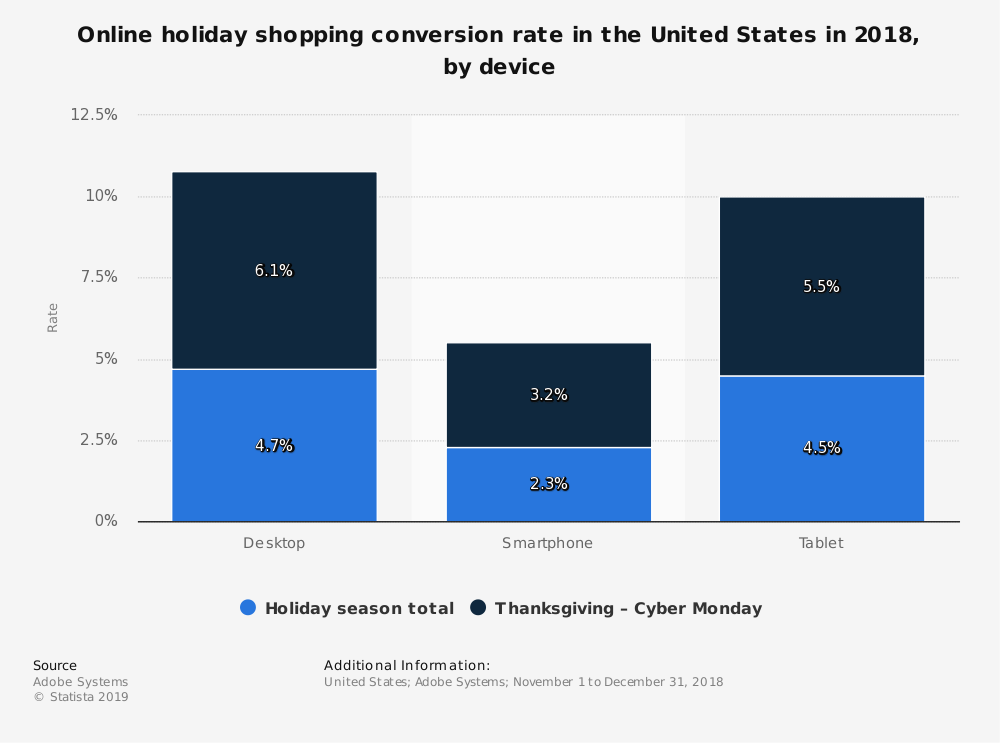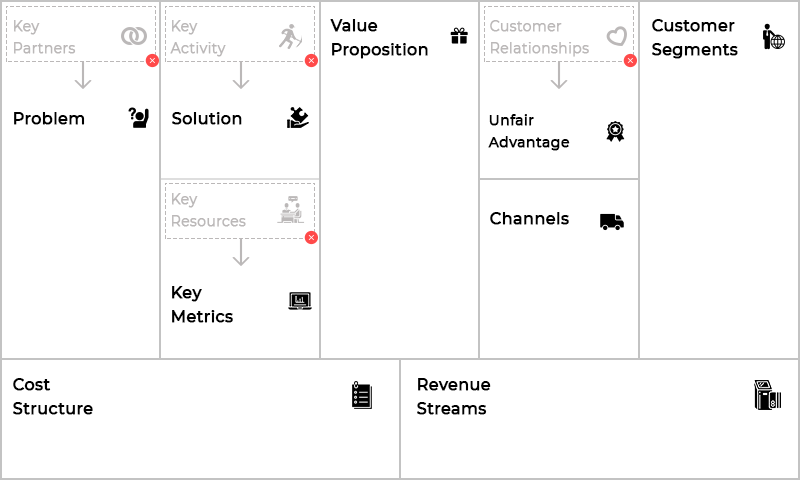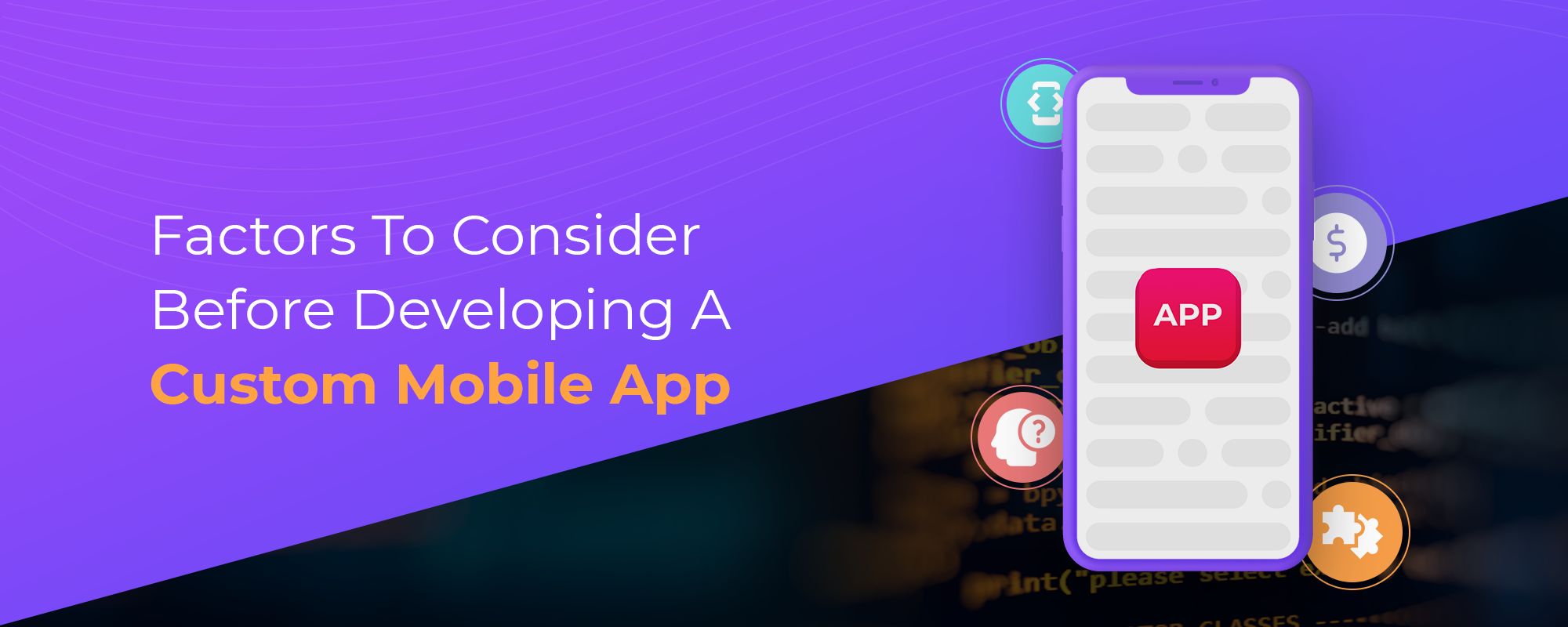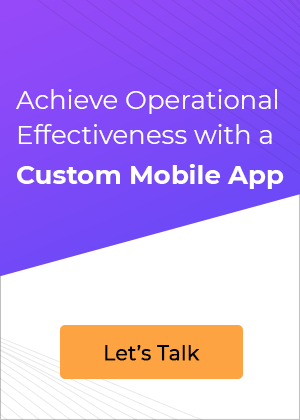The expectation of mobile app users is evolving. The users of 2020 expect the mobile app design to be intuitive, features that add convenience, and perform fast enough on an older Android or iOS device. The above expectations are my general observations that apply to any mobile application. For each business, custom mobile app development may have a completely different meaning, where few key performance indicators (KPIs) reflect the return on investment (ROI).
Take an example of the online holiday shopping conversion rate in the United States. In 2018, Businesses saw 6.1% conversions for Thanksgiving and Cyber Monday collectively. On the other hand, businesses leveraging the mobile app observed an additional 3.2% conversions during Thanksgiving along with Cyber Monday.
 Click to Enlarge
Click to Enlarge
Depending on your marketing objectives, budget, and the industry you deal in, leveraging a mobile app for your business will depend on more such factors. In this blog post, I shall share different factors to consider before developing a native mobile app for your business.
Factors to Consider Before Developing a Custom Mobile App
Create a Lean Canvas
Unlike the traditional business model canvas created by Alex Osterwalder, the lean canvas is more customer-centric and startup-friendly. For a business to improve the success rate of its new mobile app, the lean canvas adds value by giving direction to your market research.
Few changes in the business model canvas which qualify the modified version as the lean canvas are Problems, Solutions, Unfair Advantage, and Key Metrics.

The modified fields in the lean canvas enable businesses to focus their effort on identifying the problem and avoid developing the wrong mobile app or integrating third-party applications that are not preferred by the target audience.
In the field, “Solution”, businesses can brainstorm possible ways to address the problem. A recent trend in mobile app development is the adoption of lean methodology, which aligns with the “Solution”. Entrepreneurs adopt lean mobile app development primarily to check the market acceptance of their product.
Identifying the right Key Metrics enables a business to avoid exhausting resources in wrong activities. An ideal example can be – After developing a minimum viable product (MVP), you invite industry influencers for feedback. In such a case, you can monitor the engagement rate or opt eye-tracking study to bring precision in your MVP.
Facing competition is inevitable for a product or service-based company. If your mobile app becomes successful, you are bound to face competition. Many will try to copy your idea and repeat your success story. To protect your idea, the “Unfair Advantage” section is the right place where you can list pointers for the sustainability of your business.
Create a Mobile App Monetization Strategy
The most popular mobile app monetization strategies are in-app purchase (IAP) and subscription. Advertisement is another source of revenue, but selecting this monetization strategy entirely depends on the mobile app type and the industry you operate in.
Ideally, mobile apps with IAP are free to download. IAP performs well if the app comes with an intuitive design and essential features that add value. After installing the mobile app, if the user continues to use it for a few days, it means that your mobile app was able to engage the user. After this behaviour is observed, an IAP may follow.
The subscription monetization strategy is based on providing a seamless experience and incentivizing features in the mobile app. According to research by VisionMobile, subscription-based apps earn fifty percent more than IAP. Such mobile apps earn more as the user can leverage the full version at a fraction of one-time cost, and consistent value is added through upgrades or new content.
Choose a Technology Stack for Custom Mobile App Development
Each component of the mobile app technology stack has a unique purpose and fulfil a specific business requirement. Unique value propositions (UVPs) such as scalability, customizability, and maintainability depend on the technology stack you select to develop your custom mobile application.
Android Technology Stack – Java is the preferred programming language for native Android mobile app development. The recent adoption of Kotlin by Google for Android Studio has shifted the focus away from Java. And it is so for a very good reason. Kotlin is a lightweight, easy to read, and stable programming language for native Android mobile app development.
In addition to Kotlin, Android Studio, and Android Development Tools (ADT) are an integral part of the toolkit. The Android development toolkit enables one to seamlessly edit code, debug, analyze, and deploy a mobile app. To develop an Android mobile application with agility, the ADT offers a graphical user interface (UI) builder.
iOS Technology Stack – To develop native iOS mobile apps, the Swift programming language is the preferred option. It is a powerful and intuitive programming language which is less error-prone. Swift is created while considering design thinking, safety, and speed. It works exceptionally well for large enterprises where security and speed are of significant importance.
For iOS mobile app development, the toolkit contains Apple Xcode and iOS software development kit (SDK). The integrated development environment (IDE), Xcode, comes with a UI builder, code editor, debugger, and more. To enable an iOS mobile app developer to write better code, Xcode offers documentation as well. The SDK comes bundled with an application programming interface (API) to establish a link between the native iOS app and devices such as Mac, iPad, iPhone, and iWatch.
Finalize Custom Mobile App Development Project Requirements
The budget and time frame of a custom mobile app development project depends on several factors, such as design, type of mobile app, and third-party integrations. For better understanding, we would like to discuss the above in more detail. Let’s first discuss the mobile app design. Depending on the budget, there are two options – use of a template and custom mobile app design.
The two main types of custom mobile apps are – native and hybrid. The benefits of selecting native mobile app development over hybrid include superior performance, better stability, and immersive user experience.
Third-party integrations are established apps, and by leveraging this API, you can integrate their features into your mobile application. The main categories of third-party integrations include – databases, customer relationship management (CRM) solutions, enterprise resource planning (ERP) solutions, content management systems (CMS), payment gateways, analytics, and more.
The average cost of a native mobile application with few third-party integrations can easily be around 15,000 USD to 25,000 USD and may take 2 to 4 months. The requirement for a native mobile app with several third-party integrations can easily be more than eight months and may require a budget of above 75,000 USD.
Go with a Minimum Viable Product and add new Features with Each Iteration
Conclusion
Launching a custom mobile app is easy. However, if the target audience does not appreciate the UI of your mobile app, the monetization strategies may fail. If you provide the wrong features in your mobile app, the success rate of your app may decrease.
If you have a doubt regarding custom mobile app development, then do share it in the comments below. Alternatively, if you would like FATbit to develop a custom mobile app for your business, then feel free to share the requirements by using the contact us form.




Comments (2)
 Angel Ana
Angel Ana
 FATbit Chef
FATbit Chef
Thanks for the vital tips.This will help new E-commerce business holders to build their app and hold their position in the market.
Hi Angel,
Thanks for the appreciation.
Regards,
Team FATbit